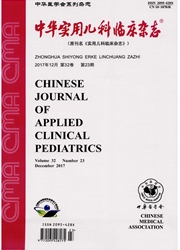

 中文摘要:
中文摘要:
目的观察应用咪唑立宾(MZR)治疗频复发型NS患儿尿蛋白转阴,血清蛋白、胆固醇恢复及复发情况。方法18例频复发型NS患儿在给予足量激素的同时,加用MZR口服,观察患儿尿蛋白转阴时间,血清蛋白、胆固醇、尿N-乙酰-13-D-氨基葡萄糖苷酶(NAG)恢复情况,并比较应用MZR0.5年以上患儿与单用激素时的复发频次。结果足量激素与MZR联合应用后,18例患儿中1例无效,1例失访,余16例患儿于1个月复查时水肿均消退,尿蛋白转阴时间为3—10d(平均6.33d)。10例定期复查达6个月患儿中8例血清蛋白于1个月时恢复正常(〉135g/L),1例于3个月时恢复正常,另1例于6个月时恢复正常。复查胆固醇,7例1个月时降至正常(〈5.7mmol/L),另3例均于3个月时降至正常。24h尿蛋白定量于1个月后复查时发现均较用药前减低,7例为阴性(〈0.4g),2例减少,1例无变化。用药后肾小管功能(用尿NAG表示)亦有恢复,用药1个月后7例恢复正常,1例仍有升高,9例较前下降;本组患儿未出现呕吐、腹泻等胃肠道症状,用药前后血压、呼吸、心率等均处于正常范围,仅1例出现BUN与CT增加。结论MZR联合足量激素治疗频复发型NS可促进患儿尿蛋白转阴,血清蛋白、胆固醇、尿NAG下降,并可减少复发。当MZR常规剂量应用不能有效减少复发频次,冲击治疗可能为一种有效方法。
 英文摘要:
英文摘要:
Objective To observe urinary protein, serum albumin, cholesterol and recurrence of children with frequency recurrence nephrotic syndrome (NS) after using Mizorbine (MZR). Methods Eighteen cases of recurrent frequency NS were given enough hormone and MZR. Urinary protein, serum albumin, cholesterol, urinary N-acetyl-β-D- glucosaminidase(NAG) and recurrence were observed. The difference of recurrence between the children treated with steroid and the children treated with steroid and MZR more than 6 months were compared. Results In the combined treatment with both sufficient hormone and MZR, out of the 18 cases, there were one lost case and one invalid case. For the remaining 16 eases, edema subsided when they were reexamined in the first month, and the urine protein changed to negative within about 3 to 10 days ( the average time was 6.33 days). There were 10 cases who were ree- xamined after 6 months, in which for 8 cases the serum albumin returned to normal in the first month ( ~〉35 g/L) , 1 case returned to normal in 3 month and 1 case in 6 month. The level of blood cholesterol returned to normal for 7 cases in the first month ( 〈5.7 mmol/L) ,3 cases returned to normal in 3 months. In the reexamining of urine protein in 24 hours in the first month,7 eases returned to normal ( 〈0.4 g) , 2 cases reduced and there was no change in 1 case. Relapse occurred in 2 cases, in one of which the level of urine protein returned to normal if changing the MZR to alter- nate-day implosive therapy. After treatment, partial tubular functions restored and in the first month, the level of NAG returned to normal in 7 cases, decreased in 9 cases and increased in 1 case. In the experiment group, no child was ob- served vomiting, to have diarrhea and other gastrointestinal symptoms. The blood pressure, breathing and heart rate were within the normal range before and after the treatment. The increase of urea nitrogen and creatinine was observed only in 1 case. Conclusions MZR with enough hormone treati
 同期刊论文项目
同期刊论文项目
 同项目期刊论文
同项目期刊论文
 期刊信息
期刊信息
